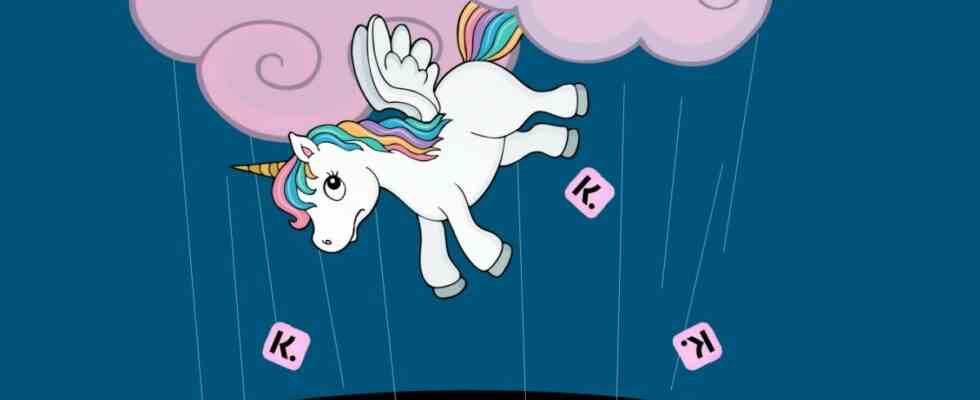Sebastian Siemiatkowski has apparently never lacked for great visions. “We are coming for you,” he wrote on Twitter in December 2021, which loosely translated means: We’ll get you. The founder had none other than Paypal in mind, the prototype of a financial start-up, so to speak, and today worth 100 billion US dollars. Hubris? Maybe. But back then, in December 2021, the Swede Siemiatkowski was actually not that far from his goal. His Klarna company, just 17 years old, was a 40-fold unicorn. This is what investors call start-ups that are worth more than a billion euros or dollars. Klarna from Sweden was worth 45 billion euros and Siemiatkowski’s founder was well on the way to being what he writes about himself on the Internet: “the nightmare of the global banking establishment!”
Nine months later, Klarna hit the ground with full force. In a new round of financing, investors value what was once Europe’s most valuable start-up at just US$ 6.5 billion, a fraction of the previous value. Then came the half-year figures: the company made a loss of 580 million euros in the first six months of 2022, three times as much as a year ago. The costs exploded, the expensive expansion into the USA took revenge in the short term. Siemiatkowski had to pull the ripcord: 700 employees and thus around ten percent of his workforce were thrown out by Klarna. Is there a unicorn falling out of the rainbow?
Consumer advocates regularly criticize Klarna
Klarna, for a long time, that was a fairy tale that founders told each other at night before going to bed. In 2005, Siemiatkowski founded the company with friends and they quickly won a famous financier from the USA as an investor and received awards. Growth followed, followed by acquisitions and more and more money from investors. During these years the company changed. At first, Klarna stayed in the background as a payment processor, but over the years it has gained more and more presence among end consumers. Today the Swedish company offers a bank account, credit cards and a so-called “super app”.
However, German customers know the Swedish financial company for its “Buy now, pay later” products (buy now, pay later), where consumers can choose to pay off their goods after 30 days or in installments. Klarna earns double from this: On the one hand, the company collects a fee from the merchants for processing the payment. On the other hand, the company can gild the customer’s installment loans with an interest rate of 9.99 percent per year. Consumer advocates criticize this business model because it leads to overconsumption. They fear that young people in particular will continue to buy on credit. Klarna disagrees and refers to the low default rate of its loans.
The environment for start-ups has become more difficult
Overconsumption or not: Siemiatkowski recognized early on that “buy now, pay later” offers are a multi-billion dollar market. Accordingly, Klarna expanded excessively from 2020 at the latest and burned a lot of money in the process. Because in order to acquire new customers, the company also has to serve customers who do not repay their loans regularly or not at all, which in turn eats up the margin. In addition, there are marketing and personnel costs for the expansion. “Looked at soberly, Klarna was profitable for many years before being driven by cheap money to focus on growth at any price,” observes e-commerce expert Philipp Klöckner.
Then came the corona crisis, disrupted supply chains, the turnaround in interest rates and inflation – and suddenly the money was no longer so easy. In Germany, for example, financiers only invested 2.9 billion euros in the second quarter of 2022, almost five billion euros less than a year earlier. Heike Hölzner, professor at HTW Berlin, does not want to speak of a crisis just yet, but of a “consolidation” that is now leading to “more realistic assessments and also to the viability of the business model of the start-ups coming back into focus .”
The business figures offer bright spots
Profitability instead of growth? At Klarna, they now want to rely on it, the company assures. But it won’t be easy. Because the consumer climate is becoming more difficult and they are now fighting for market share with competitors such as Apple or PayPal. “That has a negative effect on the margins,” says Klöckner.
Expensive expansion, new competition, difficult market environment: Klarna is feeling all of this, as the half-year figures show. There is a tripling of the loss and one cost block in particular is causing the company problems: the employees. In recent years, the financial services provider has created more than 2,000 new jobs to support the expansion. Now the “cost apparatus has to be reduced”, Klöckner analyzes and expects that the Swedish company will have to cut another 20 percent of its jobs in the long term, which Klarna strongly denies. The ten percent, Siemiatkowski stresses publicly, was a one-time thing.
So is Klarna already past the worst? A look at the business figures also offers some bright spots in addition to the horrendous losses. The company was able to increase its sales by almost a quarter, and it grew particularly quickly in Great Britain and the USA. Should the company get its costs under control in the USA in the short term and become profitable as early as the third or fourth quarter, at least the internal valuation of investors should rise again quickly. That could give the company an important boost in difficult times. On the other hand, if Siemiatkowski does not manage to get loan defaults and costs under control, the coming months are likely to be tough for the unicorn from Sweden.

